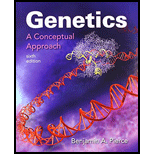
a.
To determine:
The possible codons with which the anticodon of tRNA can pair.
Introduction:
Codon consists of three
b.
To determine:
The possible codons with which the anticodon of tRNA can pair.
Introduction:
Codon consists of three nucleotides thatencode a single amino acid in the cells. There are different tRNAs that carry the same amino acid but have distinct anticodons are called isoaccepting tRNAs. One anticodon can couple with different codons through adaptability in base pairing at the third position of the codon. Wobble present at the third position of codon facilitates some
c.
To determine:
The possible codons with which the anticodon of tRNA can pair.
Introduction:
Codon consists of three nucleotides thatencode a single amino acid in the cells. There are different tRNAs that carry the same amino acid but have distinct anticodons are called isoaccepting tRNAs. One anticodon can couple with different codons through adaptability in base pairing at the third position of the codon. Wobble present at the third position of codon facilitates some
d.
To determine:
The possible codons with which the anticodon of tRNA can pair.
Introduction:
Codon consists of three nucleotides thatencode a single amino acid in the cells. There are different tRNAs that carry the same amino acid but have distinct anticodons are called isoaccepting tRNAs. One anticodon can couple with different codons through adaptability in base pairing at the third position of the codon. Wobble present at the third position of codon facilitates some
The possible codons with which the anticodon of tRNA can pair.
e.
To determine:
The possible codons with which the anticodon of tRNA can pair.
Introduction:
Codon consists of three nucleotides thatencode a single amino acid in the cells. There are different tRNAs that carry the same amino acid but have distinct anticodons are called isoaccepting tRNAs. One anticodon can couple with different codons through adaptability in base pairing at the third position of the codon. Wobble present at the third position of codon facilitates some
Trending nowThis is a popular solution!

Chapter 15 Solutions
Genetics: A Conceptual Approach 6E w/ SaplingPlus (Six-Month Access)
- 22. Which of the following mutant proteins is expected to have a dominant negative effect when over- expressed in normal cells? a. mutant PI3-kinase that lacks the SH2 domain but retains the kinase function b. mutant Grb2 protein that cannot bind to RTK c. mutant RTK that lacks the extracellular domain d. mutant PDK that has the PH domain but lost the kinase function e. all of the abovearrow_forwardWhat is the label ?arrow_forwardCan you described the image? Can you explain the question as well their answer and how to get to an answer to an problem like this?arrow_forward
- Describe the principle of homeostasis.arrow_forwardExplain how the hormones of the glands listed below travel around the body to target organs and tissues : Pituitary gland Hypothalamus Thyroid Parathyroid Adrenal Pineal Pancreas(islets of langerhans) Gonads (testes and ovaries) Placentaarrow_forwardWhat are the functions of the hormones produced in the glands listed below: Pituitary gland Hypothalamus Thyroid Parathyroid Adrenal Pineal Pancreas(islets of langerhans) Gonads (testes and ovaries) Placentaarrow_forward
 Human Anatomy & Physiology (11th Edition)BiologyISBN:9780134580999Author:Elaine N. Marieb, Katja N. HoehnPublisher:PEARSON
Human Anatomy & Physiology (11th Edition)BiologyISBN:9780134580999Author:Elaine N. Marieb, Katja N. HoehnPublisher:PEARSON Biology 2eBiologyISBN:9781947172517Author:Matthew Douglas, Jung Choi, Mary Ann ClarkPublisher:OpenStax
Biology 2eBiologyISBN:9781947172517Author:Matthew Douglas, Jung Choi, Mary Ann ClarkPublisher:OpenStax Anatomy & PhysiologyBiologyISBN:9781259398629Author:McKinley, Michael P., O'loughlin, Valerie Dean, Bidle, Theresa StouterPublisher:Mcgraw Hill Education,
Anatomy & PhysiologyBiologyISBN:9781259398629Author:McKinley, Michael P., O'loughlin, Valerie Dean, Bidle, Theresa StouterPublisher:Mcgraw Hill Education, Molecular Biology of the Cell (Sixth Edition)BiologyISBN:9780815344322Author:Bruce Alberts, Alexander D. Johnson, Julian Lewis, David Morgan, Martin Raff, Keith Roberts, Peter WalterPublisher:W. W. Norton & Company
Molecular Biology of the Cell (Sixth Edition)BiologyISBN:9780815344322Author:Bruce Alberts, Alexander D. Johnson, Julian Lewis, David Morgan, Martin Raff, Keith Roberts, Peter WalterPublisher:W. W. Norton & Company Laboratory Manual For Human Anatomy & PhysiologyBiologyISBN:9781260159363Author:Martin, Terry R., Prentice-craver, CynthiaPublisher:McGraw-Hill Publishing Co.
Laboratory Manual For Human Anatomy & PhysiologyBiologyISBN:9781260159363Author:Martin, Terry R., Prentice-craver, CynthiaPublisher:McGraw-Hill Publishing Co. Inquiry Into Life (16th Edition)BiologyISBN:9781260231700Author:Sylvia S. Mader, Michael WindelspechtPublisher:McGraw Hill Education
Inquiry Into Life (16th Edition)BiologyISBN:9781260231700Author:Sylvia S. Mader, Michael WindelspechtPublisher:McGraw Hill Education





